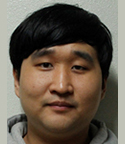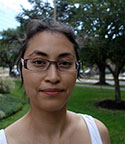Recently, we’ve been profiling first authors of Plant Cell papers that are selected for In Brief summaries. Here are the first-author profiles from the November issue of The Plant Cell.
Jaewook Kim, Kijong Song, and Eunae Park, featured authors of Epidermal Phytochrome B Inhibits Hypocotyl Negative Gravitropism Non-Cell Autonomously
Jaewook Kim
 Current Position: Graduate student, Department of Biological Sciences, KAIST, Korea.
Current Position: Graduate student, Department of Biological Sciences, KAIST, Korea.
Education: B.Sc. (2011), Department of Biological Sciences, KAIST.
Non-scientific Interests: Cooking, weight-training.
As a graduate student in Giltsu Choi’s lab in the Department of Biological Sciences, KAIST, I wanted to study how phytochromes inhibit hypocotyl negative gravitropism. When I joined the lab, Keunhwa Kim, a graduate student in the lab, had just published a paper showing PIFs inhibit hypocotyl negative gravitropism in the endodermis. My colleagues and I read the paper many times and decided to determine in which tissues phyB works. Fortunately, tissue-specific phyB lines had been already generated using many different promoters in the lab; thus, my colleagues and I were able to start the project immediately. The first things we had to do was determining which tissue-specific lines were really tissue-specific lines. After going through many ups and downs, we were able to show that epidermal phyB inhibits hypocotyl negative gravitropism non-cell autonomously. After graduation, I would like to go abroad as a postdoctoral researcher and want to discover novel aspects of light signaling.
Kijong Song
 Current Position: Graduate student, Department of Biological Sciences, KAIST, Korea.
Current Position: Graduate student, Department of Biological Sciences, KAIST, Korea.
Education: B.Sc. (2014), Department of Biological Sciences, KAIST.
Non-scientific Interests: Swimming, climbing.
When I was young, I used to visit my grandparents’ house in the countryside and spent most of weekend time playing in the yard. Insects and flowers were abundant. They were pure joys to watch, filling my mind with wonder and awe. In the college, I took a plant biology class taught by Prof. Giltsu Choi and learned how plants recognize their surroundings with photoreceptors. It re-awoke my childhood wonder in my grandparents’ yard and made me enter graduate school. As a graduate student, I’m trying to figure out how phytochromes work inside plants to regulate various light responses including seedling photomorphogenesis and hypocotyl negative gravitropism. I’m especially fascinated by non-cell autonomous function of phytochromes.
 Eunae Park
Eunae Park
Current Position: Post-Doc, Department of Biological Sciences, KAIST.
Education: Ph.D (2010), Department of Biological Sciences, KAIST.
Non-scientific Interests: Traveling, being a good mom.
Since graduate school, I have been studying how phytochromes inhibit PIFs in Giltsu Choi’s lab at the Department of Biological Sciences, KAIST. I discovered that phytochromes inhibit PIFs both by degrading PIF proteins and dissociating PIFs from their target promoters. In this paper, my colleagues and I found that epidermal phytochrome B (phyB) promote light responses by inhibiting PIFs non-cell autonomously. Very surprisingly, we found that phyB promotes the degradation of PIFs even when phyB and PIFs are spatially separated in epidermis and endodermis, respectively. I’m currently investigating how epidermal phyB degrades endodermal PIFs non-cell autonomously.
Lisa Hartmann, featured first author of Alternative Splicing Substantially Diversifies the Transcriptome during Early Photomorphogenesis and Correlates with the Energy Availability in Arabidopsis
 Current Position: Graduate student at the Center for Plant Molecular Biology at the Eberhard Karls University Tübingen.
Current Position: Graduate student at the Center for Plant Molecular Biology at the Eberhard Karls University Tübingen.
Education: Diploma (equivalent to M.Sc.) in Biochemistry (2011), Eberhard Karls University Tübingen.
Non-scientific Interests: Music, reading, knitting and crocheting.
I first got interested in alternative splicing (AS) in 2006 when I began working as a student research assistant confirming computationally predicted splicing variants for Gunnar Rätsch (now ETH Zürich) at the Friedrich Miescher Laboratory. At that time, next-generation sequencing platforms began changing life sciences, and I was fascinated with these cutting-edge techniques and the prospects that arose. For my Diploma thesis project, I wanted to keep working on AS, ideally using RNA-seq. Andreas Wachter at the Center for Plant Molecular Biology proposed the ideal project: using RNA-seq to investigate whether AS contributes to the transcriptomic differences between seedlings undergoing skoto- and photomorphogenesis. We found that this developmental transition is indeed accompanied by numerous AS shifts, and I carried on with the project for my PhD. Investigating the functional impact of selected AS events and looking into upstream regulatory mechanisms led to the finding of light- and sugar-regulated AS presented here.
